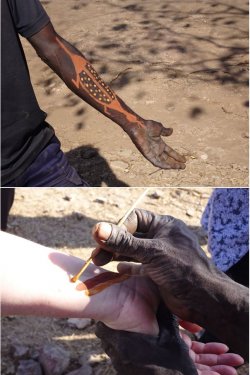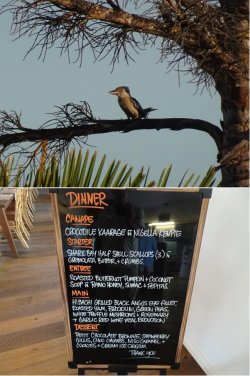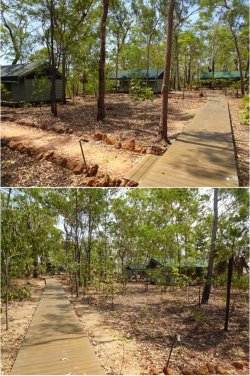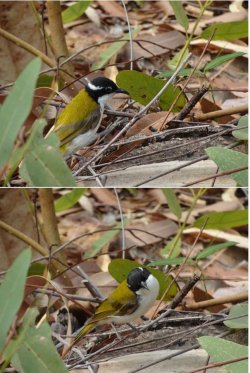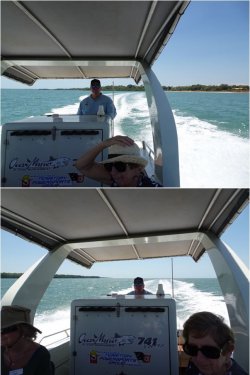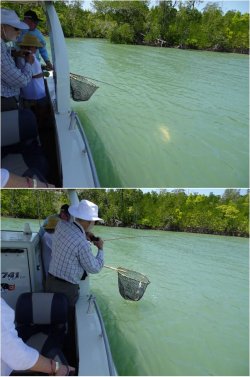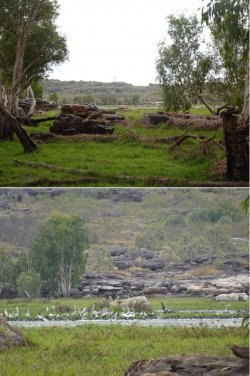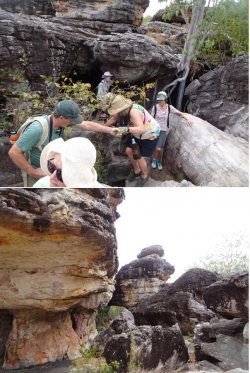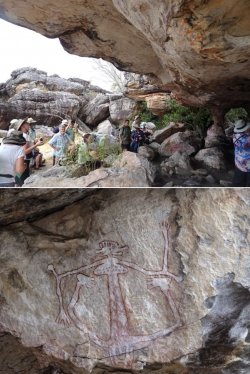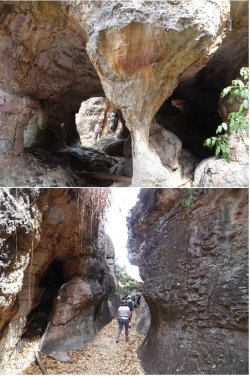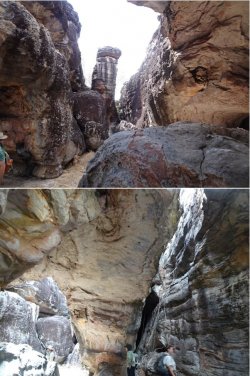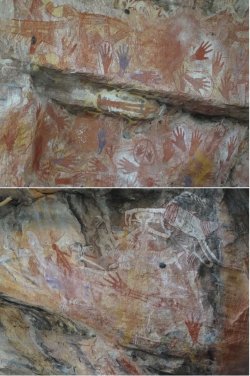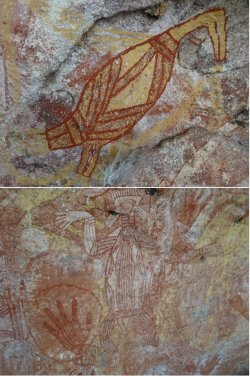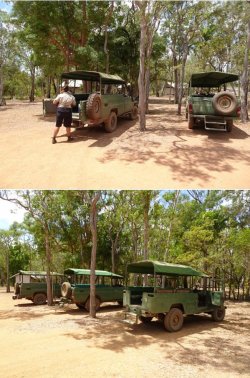You are using an out of date browser. It may not display this or other websites correctly.
You should upgrade or use an alternative browser.
You should upgrade or use an alternative browser.
Adventure across Arnhem Land
- Thread starter JohnM
- Start date
- Status
- Not open for further replies.
JohnM
Enthusiast
- Joined
- Jun 7, 2006
- Posts
- 11,464
- Qantas
- LT Gold
Next day and time to move on. First stop was only 20km or so to the indigenous art centre at the community of Ramingining. Photography is forbidden in and around any of the communities that we visited and it was also forbidden inside this art centre, where the artists were actively working. (The gallery at Yirrkala was much more a commercial outlet for indigenous artists, so it did not have the same restrictions within the gallery – but they still applied outside the building).
We entered only about three communities. In each case, it was directly to the art centre, in two instances, or the boat-launching ramp in the other, and directly out after the activity was done.
We could take photos of the two panels representing the two ‘moieties’ of the Yolngu people on the roof of the art centre verandah. With the permission of the artists working at the Ramingining art centre some photographs could be taken. I asked, got the OK and took a couple of quick shots.
I had a mixture of surprise and disappointment to see the artist painting the thin stripes with a fine small brush with very long strands. It was a plastic-handled horse-hair brush, not anything traditional. The paint had a very sticky latex-like quality, but I didn’t ask questions about its traditional authenticity. Maybe I was expecting too much. The prices being asked for all the art and weaving works were astronomical, both here and at Yirrkala.
For anyone who has visited the NGA and seen the 50 or so ‘totem poles’ exhibit, they are from the Yolngu people.



We entered only about three communities. In each case, it was directly to the art centre, in two instances, or the boat-launching ramp in the other, and directly out after the activity was done.
We could take photos of the two panels representing the two ‘moieties’ of the Yolngu people on the roof of the art centre verandah. With the permission of the artists working at the Ramingining art centre some photographs could be taken. I asked, got the OK and took a couple of quick shots.
I had a mixture of surprise and disappointment to see the artist painting the thin stripes with a fine small brush with very long strands. It was a plastic-handled horse-hair brush, not anything traditional. The paint had a very sticky latex-like quality, but I didn’t ask questions about its traditional authenticity. Maybe I was expecting too much. The prices being asked for all the art and weaving works were astronomical, both here and at Yirrkala.
For anyone who has visited the NGA and seen the 50 or so ‘totem poles’ exhibit, they are from the Yolngu people.



JohnM
Enthusiast
- Joined
- Jun 7, 2006
- Posts
- 11,464
- Qantas
- LT Gold
We then moved on to Barramundi Lodge. This was set up some time ago for fishing expeditions, but barra fishing is best in wetter times of the year. Outback Spirit bought the property and upgraded it to broaden the scope for accommodating dry-season tourists as well as the fishing people.
The Lodge was located well outside the Community at Maningrida, which was the boat-launching site for our fishing expedition.
This day’s travel was quite short and we arrived at Barramundi Lodge in time for lunch. The lodge is set on the edge of the escarpment overlooking the floodplain.





The Lodge was located well outside the Community at Maningrida, which was the boat-launching site for our fishing expedition.
This day’s travel was quite short and we arrived at Barramundi Lodge in time for lunch. The lodge is set on the edge of the escarpment overlooking the floodplain.





JohnM
Enthusiast
- Joined
- Jun 7, 2006
- Posts
- 11,464
- Qantas
- LT Gold


Then it’s PJM’s turn. Errr - that’s not a barra…
Flathead – back it goes.

And neither is this. PJM has missed the memo that this is a barra fishing expedition. Golden snapper, aka fingermark. Apparently excellent eating, but back it goes.

I didn’t miss the memo. 55cm barra. That is the legal minimum, but we already had a bigger one, so back it went. The boat ended up with 58, 63 and 70cm fish to take back to the lodge.

No barra for PJM. Naturally, that night barra was on the dinner menu. Not what we caught as it was insufficiently relaxed. We ate what the previous group caught and ours will be eaten by the next group. The difference in taste and texture between wild-caught and farmed is great.




JohnM
Enthusiast
- Joined
- Jun 7, 2006
- Posts
- 11,464
- Qantas
- LT Gold
Moving on the next day. Another fairly short drive to arrive at Mt Borradaile before lunch. This is the property of the long-established Davidson’s Arnhem Land Safaris. Other parties dealing directly with them, and that mostly fly in, are also accommodated at this larger camp.
The focus is on visiting the many indigenous rock-painting sites and the Kakadu-like wetlands.
All perfectly good, but not up to the level and finesse of Outback Spirit’s own properties.
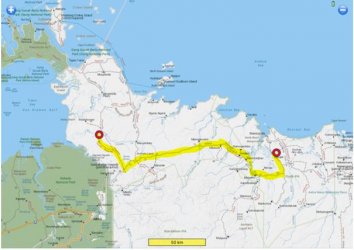
Fuelling up before departure and a rather interesting spider’s web on the deck.
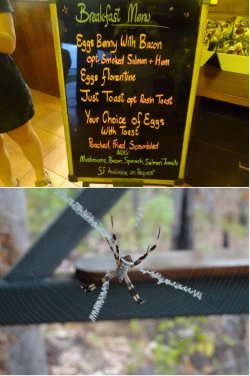
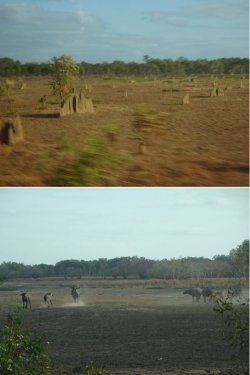


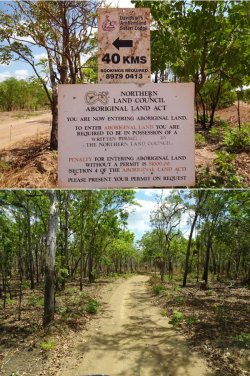
The focus is on visiting the many indigenous rock-painting sites and the Kakadu-like wetlands.
All perfectly good, but not up to the level and finesse of Outback Spirit’s own properties.

Fuelling up before departure and a rather interesting spider’s web on the deck.





JohnM
Enthusiast
- Joined
- Jun 7, 2006
- Posts
- 11,464
- Qantas
- LT Gold
After lunch we went on our first excursion to a rock art site. There are many sites on the property and we visited two during our day and a half there. The first one was quite close to the lodge, while the larger site the next day was further out.
There was a variety of (windowless) transport. We had to laugh at the ‘smash glass’ hammer still mounted in the bus.

Turkey bush.

Getting into some spinifex country. That stuff burns right down to a small tussock that soon re-shoots.
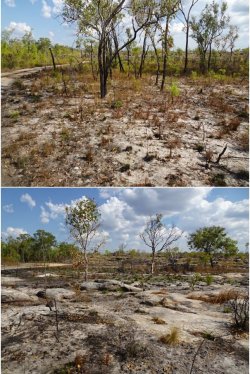




There was a variety of (windowless) transport. We had to laugh at the ‘smash glass’ hammer still mounted in the bus.

Turkey bush.

Getting into some spinifex country. That stuff burns right down to a small tussock that soon re-shoots.





drron
Veteran Member
- Joined
- Jul 4, 2002
- Posts
- 36,086
I now have pleasure in welcoming PJM to the You Caught the Wrong Fish club. Both my son and myself have caught Spanish mackerel when bottom fishing for coral trout and coral trout when trolling for spanish mackerel.
But my best was when fishing off Mornington Island. Our very experienced guide had no idea what I had hooked other than it was big as it took a fair amount of line out. When I finally pulled it in it was a very large spanish mackerel. Except I had pulled it in backwards as the line was twisted around it's tail. As the guide said there is a first time for everything and that is definitely the first time I have seen a fish lassoed.
But my best was when fishing off Mornington Island. Our very experienced guide had no idea what I had hooked other than it was big as it took a fair amount of line out. When I finally pulled it in it was a very large spanish mackerel. Except I had pulled it in backwards as the line was twisted around it's tail. As the guide said there is a first time for everything and that is definitely the first time I have seen a fish lassoed.
✅ Compare prices instantly in one place, in real-time
✅ Add Zyft to your browser or use the App on any mobile device
✅ Scan a barcode in the app for instant price comparison
Be clever, shop better – with Zyft.
✅ Add Zyft to your browser or use the App on any mobile device
✅ Scan a barcode in the app for instant price comparison
Be clever, shop better – with Zyft.
AFF Supporters can remove this and all advertisements
- Status
- Not open for further replies.
Become an AFF member!
Join Australian Frequent Flyer (AFF) for free and unlock insider tips, exclusive deals, and global meetups with 65,000+ frequent flyers.AFF members can also access our Frequent Flyer Training courses, and upgrade to Fast-track your way to expert traveller status and unlock even more exclusive discounts!

AFF forum abbreviations
Wondering about Y, J or any of the other abbreviations used on our forum?Check out our guide to common AFF acronyms & abbreviations.
Recent Posts
-
-
FINNAIR - new Business Class AirLounge seat
- Latest: FlyingFiona
-
-
Currently Active Users
- benjy
- muppet
- AIRwin
- henleybeach
- ghost
- Flyerqf
- SydneySwan
- Happy Dude
- harvyk
- FlyingFiona
- Lynda2475
- brett-au
- Hawk529
- Pete98765432
- bernardblack
- larry40
- delphiki89
- N0mad
- HealthyPotato
- hj.au
- Happy Trails
- Austman
- RSD
- pyffii
- Daver6
- Harrison_133
- Kazb61
- smsh63
- TonyDoh
- kileskus
- DFWorldtraveller
- Lady Emily
- justinbrett
- cranky
- snooze
- Coops1
- SYD
- WeeWillyWonka
- Notyourbag
- TheRealTMA
- desafinado74
- BrianQQ
- Jay684
- chingy17
- Scr77
- asterix
- kpro
- Human
- Kwong
- There'sOnlyOneJimmy
Total: 503 (members: 72, guests: 431)










